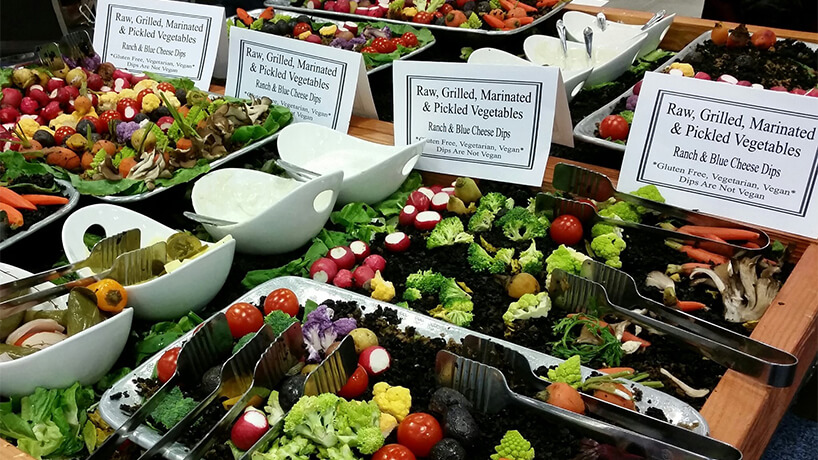
By David McMillin
When approximately 2,000 attendees sat down for lunch at the Association for the Advancement of Sustainability in Higher Education Annual Conference, they were fed all plant- based food, all conference long.
As Kimberly Smith was reviewing feedback after the 2016 Association for the Advancement of Sustainability in Higher Education (AASHE) Annual Conference, she kept coming across the same complaints: The event’s F&B options had left attendees with a bad taste in their mouths. “2016 didn’t work out so well,” Smith, the director of conferences and events for AASHE, told PCMA in a recent interview. “We got slammed on our evaluations. Vegans didn’t have enough choices. I had to do a special meal for people who had very unique chemical allergies. It was overwhelming to create a program that pleased our attendees.”
In addition to accommodating individual dietary preferences and restrictions, some of the 2,000 attendees questioned why the menu was at odds with the organization’s mission to advance sustainable practices. “Some of our members asked why we were still serving meat at our conferences,” Smith said. “We’re focused on sustainability and lowering the carbon footprint, but animal-based foods are generally more resource-intensive than plant-based foods.”
So Smith made a bold move: She decided to move forward with an all-vegetarian menu. “It was a wake-up call,” Smith said. “I deduced that we’re going vegetarian from here on out.”
Collaborating With the Catering Company
Smith had a head start on the transition. AASHE had embraced a Meatless Monday campaign at past conferences. However, it’s no secret that chicken shows up on nearly every menu at meetings and events. As Smith looked ahead to her 2017 conference in San Antonio, she knew that she would have to develop a close relationship with her caterer, the RK Culinary Group at the Henry B. Gonzalez Convention Center, to explore meat and poultry alternatives.
“Last year’s caterer was fantastic,” Smith said. “I met with the chef, and he really listened to my vision. I shared some vegetarian recipes I found that seemed like they might be good for our audience. I listened to his advice. It was a very close collaboration. We met face-to-face, and I shared a document with my catering standards. After some back-and-forth, we did a tasting. Out of five dishes, I think I chose three and made some small modifications to the others.”
Breaking up With Breakfast, Creating a More Balanced Budget
In addition to the conference’s first-ever, all-vegetarian menu, Smith made another big move in 2017 by eliminating breakfast from the menu. “Taking this step allowed me to put more money into creating more bountiful lunches,” Smith said. “We had six hotels, and every single one of them offered a buffet breakfast with great options. Eliminating this one meal allowed me to put more money into the lunches and refreshment breaks.”
While Smith used to only serve coffee and tea during those breaks, she said that the adjustment gave her the extra budget room to include food outside of traditional lunchtime. Smith said that the average price of a meal decreased by $4 in a year-over-year comparison.
 Looking Ahead, Analyzing Every Ingredient
Looking Ahead, Analyzing Every Ingredient
That budget adjustment was good news for the organization’s bottom line, but as any event organizer knows, it’s impossible to please everyone. “Not everyone thought we should go meatless,” Smith said. “Even some of our staff indicated that they weren’t sure of the decision. But overall, the majority of our post-event feedback indicated that it was a step in the right direction and demonstrated a commitment to sustainability.”
The 2018 AASHE Annual Conference kicks off in Pittsburgh on Oct. 2, and Smith is pursuing an ambitious meal plan for the upcoming gathering. “I want to move to a completely plant-based menu,” Smith said. “I’m not sure if I’ll be able to, but I’m going to try.”
Smith is working with Levy to add more raw foods to the offerings with an aim to eliminate dairy from the menu. “If I eliminate dairy, I won’t have cheese,” she acknowledged. “What conference doesn’t have cheese? Considering the energy that goes into the cow, though, it has a huge environmental footprint.”
In addition to advancing the organization’s mission, all that plant power can pay off in another way. “Last year, we had an increase in our social-media activity because attendees were sharing more pictures of their food,” Smith said. “In 2018, I hope we can do something really unique with our opening reception with raw and grilled vegetables displayed in garden boxes. I want attendees to feel like they’re picking from a garden.”
Key Takeaway for Your Menu
Smith’s experience in planning F&B for AASHE has provided her with a valuable lesson that makes sense for all event organizers: “I always ask the caterer what the menu is shaping up to look like for the groups meeting before our conference,” she said. “That way, we can explore opportunities for menu matching and create economies of scale. I believe it’s vital to show suppliers how I’m saving them money, and as a result, making them money while reducing my costs.”
This article was originally published on PCMA’s website.